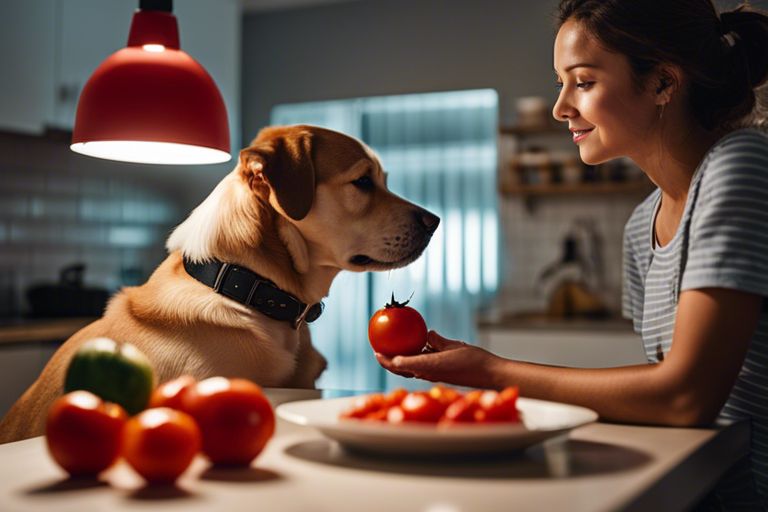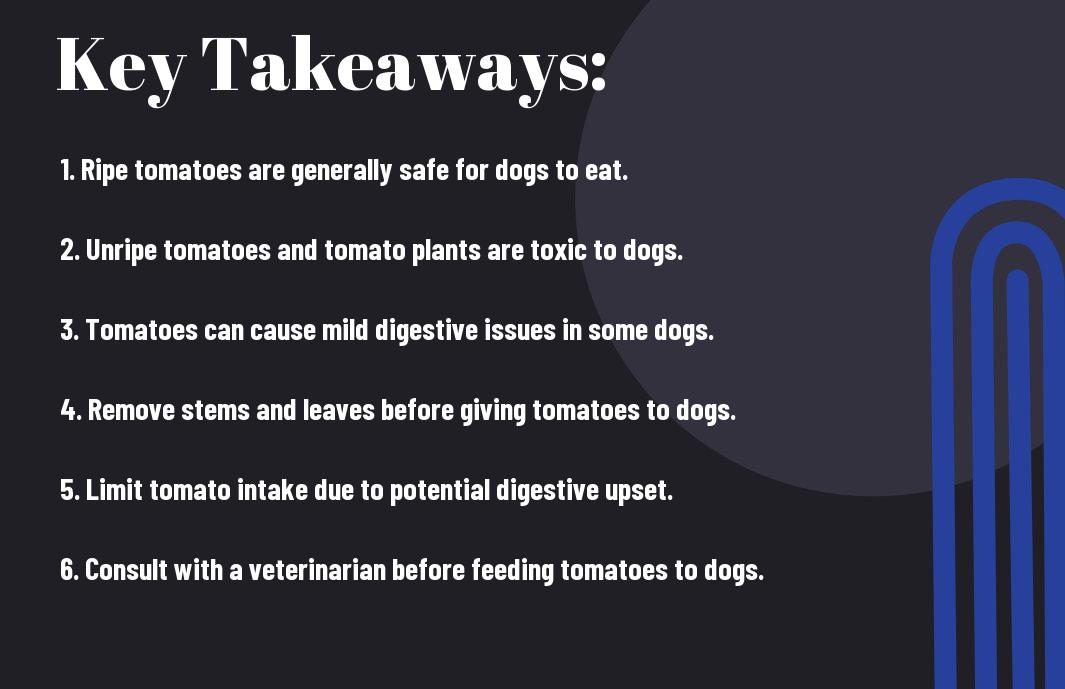Tomatoes, a common ingredient in many dishes, may seem harmless for you, but have you ever wondered if they are safe for your furry friend to consume? In this informative piece, we’ll explore the potential risks and benefits of feeding tomatoes to your dog. As Malcolm Gladwell would dissect a complex topic, we’ll unravel the mysteries behind tomatoes and your dog’s health, guiding you towards making the best decisions for your four-legged companion.
Key Takeaways:
- Tomatoes in moderation: While tomatoes are not toxic to dogs, they should be given in moderation due to the presence of solanine which can be harmful if consumed in large quantities.
- Green tomatoes and stems: Green tomatoes and the stems of the plant contain higher levels of solanine and are more toxic, so it’s best to avoid giving these parts to your dog.
- Safe alternatives: If you want to give your dog a vegetable treat, consider safe options like carrots, green beans, or cucumbers, which are low in calories and offer health benefits.
The Toxicity of Tomatoes
The Solanine Content
A potential concern when it comes to dogs consuming tomatoes is the solanine content present in the green parts of the plant, such as the leaves and stems. Solanine is a toxic compound that can be harmful to dogs if ingested in large quantities. While the ripe fruit of the tomato is generally safe for dogs to eat in moderation, the green parts contain higher levels of solanine that could be dangerous for your furry friend.
The Risks of Tomato Leaves and Stems
An additional risk associated with allowing your dog to consume tomato plants is the potential for gastrointestinal upset. If your dog eats tomato leaves or stems, they may experience symptoms such as vomiting, diarrhea, or abdominal pain. In more severe cases, ingestion of these parts of the plant could lead to lethargy or even more serious complications.
Plus, some dogs may be more sensitive to the toxic compounds in tomato plants than others. Young puppies, senior dogs, or dogs with pre-existing health conditions may be at higher risk of adverse reactions if they ingest tomato leaves or stems. To keep your furry companion safe, it’s best to prevent them from eating any part of the tomato plant and stick to offering them only the ripe fruit as an occasional treat.
The Effects of Tomato Consumption on Dogs
Gastrointestinal Issues
Even though tomatoes are not considered toxic to dogs, consuming them in large quantities can lead to gastrointestinal issues. Your dog may experience stomach pain, diarrhea, vomiting, or even tremors due to the high acidity of tomatoes. If your dog shows any of these symptoms after eating tomatoes, it’s best to contact your vet for advice.
Neurological Symptoms
Dogs can also exhibit neurological symptoms after consuming tomatoes. These symptoms may include weakness, confusion, or dilated pupils. While rare, some dogs may even experience seizures. If you notice any of these neurological symptoms in your dog after they have eaten tomatoes, seek veterinary attention immediately.
Neurological symptoms can be serious and should not be ignored. It’s important to monitor your dog closely and take note of any abnormal behavior if they have ingested tomatoes.
Cardiovascular Problems
Tomatoes contain tomatine and solanine, which are both toxic compounds when consumed in large amounts. Ingesting these compounds can lead to cardiovascular problems in dogs, such as irregular heartbeats or an elevated heart rate. If your dog shows signs of cardiovascular distress after eating tomatoes, seek immediate veterinary care.
This highlights the importance of being cautious with the amount of tomatoes you feed your dog. While small amounts may not cause any issues, overindulgence can lead to serious health complications for your furry friend.
Factors Influencing Tomato Toxicity in Dogs
Many factors can influence the toxicity of tomatoes for your furry friend. Here are some key points to consider:
- Ripeness and Green Tomatoes
- Cherry Tomatoes and Other Varieties
- Cooking and Processing Tomatoes
Ripeness and Green Tomatoes
With regards to ripeness, the level of solanine in tomatoes can vary. Solanine is a toxin found in the green parts of tomatoes as well as in unripe green tomatoes. Therefore, while fully ripe red tomatoes are less likely to cause harm to your dog, unripe or green tomatoes can be potentially toxic.
Cherry Tomatoes and Other Varieties
An important point to note is that cherry tomatoes and certain other tomato varieties may have a higher concentration of solanine compared to larger tomatoes. This means that even a small amount of cherry tomatoes can pose a risk to your dog if ingested.
A common misconception is that only the green parts of tomatoes are toxic to dogs. However, the truth is that all parts of the tomato plant, including the stems and leaves, contain solanine, which can be harmful to your furry companion.
Cooking and Processing Tomatoes
Processing tomatoes, such as in the form of sauces or ketchup, can reduce the levels of solanine present in the fruit. Cooking tomatoes can also help break down the toxins, making them safer for your dog to consume in moderate amounts.
Varieties containing a higher level of solanine are generally considered unsafe for dogs. Always keep in mind that individual dogs may react differently to tomatoes, so it’s crucial to monitor your pet for any signs of distress or discomfort after consumption.
Safe Alternatives for Dogs
Healthy Fruits and Vegetables
Not all fruits and vegetables are safe for your furry friend to consume. Some, like tomatoes, can be harmful to dogs. However, there are plenty of safe alternatives that you can offer your pup as a healthy snack.
Nutritious Treats and Snacks
Safe alternatives for your dog’s treats and snacks include crunchy carrots, sweet apples (without seeds), and juicy watermelon (without seeds). These options are not only safe for your dog to eat but also provide important vitamins and minerals to support their overall health.
Healthy treats and snacks can also be a great way to reward your dog during training sessions or as a special treat. Just remember to offer them in moderation to prevent any digestive issues.
Preventing Tomato Poisoning in Dogs
Despite the potential risks associated with dogs consuming tomatoes, there are steps you can take to prevent tomato poisoning in your furry friend. By securing tomatoes and plants, monitoring your dog’s behavior, and being prepared with emergency response and first aid, you can help keep your dog safe.
Securing Tomatoes and Plants
Any tomatoes or tomato plants in your garden should be kept out of reach of your dog. Consider fencing off the area or using raised planters to prevent easy access. Additionally, make sure to store any harvested tomatoes in a secure location where your dog cannot access them.
Monitoring Your Dog’s Behavior
Monitoring your dog’s behavior is crucial in preventing tomato poisoning. Keep an eye out for signs such as vomiting, diarrhea, lethargy, or changes in appetite. If you suspect your dog has ingested tomatoes or is showing any unusual symptoms, contact your veterinarian immediately.
Dogs may show signs of distress or discomfort after consuming tomatoes. It’s important to act quickly and seek medical attention if you notice any concerning symptoms in your pet.
Emergency Response and First Aid
With the potential for tomato poisoning in mind, familiarize yourself with basic first aid techniques for dogs. In case of emergency, have the contact information for your veterinarian and a pet poison helpline readily available.
Poisoning can occur rapidly, so it’s vital to act promptly if you suspect your dog has ingested tomatoes. Time is of the essence in providing the necessary treatment to help your dog recover.
Dealing with Tomato Poisoning in Dogs
Recognizing the Symptoms
To recognize the symptoms of tomato poisoning in your dog, observe for signs such as vomiting, diarrhea, lethargy, confusion, weakness, and even behavioral changes. If you notice any of these symptoms after your dog has consumed tomatoes, it is vital to act quickly and seek veterinary care.
Seeking Veterinary Care
One of the first steps in dealing with tomato poisoning in dogs is to seek veterinary care immediately. Contact your veterinarian or the nearest emergency animal hospital for guidance on what steps to take next. They may ask you about the quantity of tomatoes ingested, the time elapsed since ingestion, and your dog’s current symptoms.
Poisoning from tomatoes can lead to serious complications if not addressed promptly. Your veterinarian may recommend inducing vomiting to prevent further absorption of toxins, administering activated charcoal to absorb the toxins, or providing supportive care such as intravenous fluids and medication to manage symptoms.
Treatment Options and Recovery
Seeking immediate veterinary care is crucial in treating tomato poisoning in dogs. Depending on the severity of the poisoning, your dog may need to stay at the veterinary hospital for monitoring and supportive care. The recovery process can vary based on the amount of tomatoes ingested and your dog’s overall health.
The treatment options and recovery from tomato poisoning will be tailored to your dog’s specific condition. It is vital to follow your veterinarian’s advice closely and provide a safe and calm environment for your dog to recover in. With proper care and attention, most dogs can make a full recovery from tomato poisoning.
Conclusion
Taking this into account, it is safe for dogs to eat tomatoes in moderation. While they are safe for consumption and can provide some health benefits, it is important to remember that tomatoes contain solanine and tomatine, which can be harmful in large quantities. Always consult with your veterinarian before introducing any new foods into your dog’s diet to ensure their overall health and wellbeing.
FAQ
Q: Can dogs eat tomatoes?
A: Yes, dogs can eat tomatoes in moderation. However, there are certain parts of the tomato that can be harmful to them, so it’s important to know which parts are safe for consumption.
Q: Are tomatoes toxic to dogs?
A: While ripe tomatoes are generally safe for dogs to eat, the green parts of the plant, such as the leaves and stems, contain a toxic substance called solanine that can be harmful to dogs if ingested in large amounts.
Q: What are the benefits of feeding tomatoes to dogs?
A: Tomatoes are a good source of vitamins A, C, and K, as well as potassium and folate. These nutrients can provide some health benefits for dogs, such as supporting their immune system and overall well-being.
Q: How should tomatoes be prepared for dogs to eat?
A: It’s best to feed dogs ripe, red tomatoes that have been washed thoroughly to remove any pesticides or harmful bacteria. The tomatoes should be cut into small, bite-sized pieces to prevent choking hazards.
Q: What are the potential risks of feeding tomatoes to dogs?
A: Overconsumption of tomatoes can lead to gastrointestinal issues in dogs, such as vomiting and diarrhea. Additionally, some dogs may be allergic to tomatoes, so it’s important to monitor your dog for any adverse reactions after feeding them this fruit.
Are strawberries toxic for dogs
Demystifying Anal Gland Issues in Dogs: Your Comprehensive Guide from the American Kennel Club




